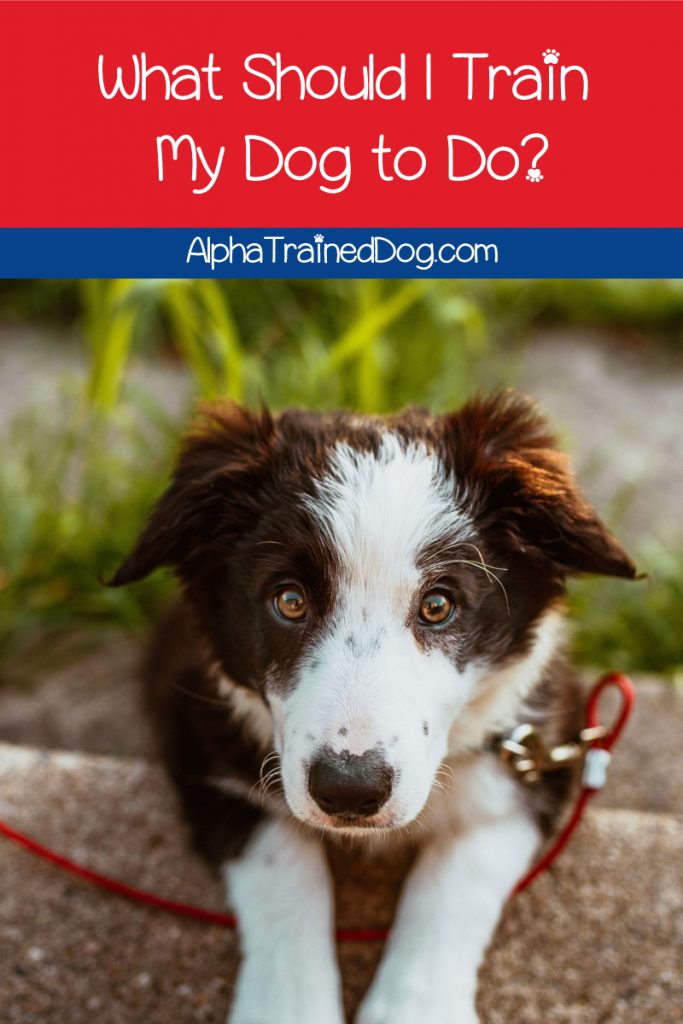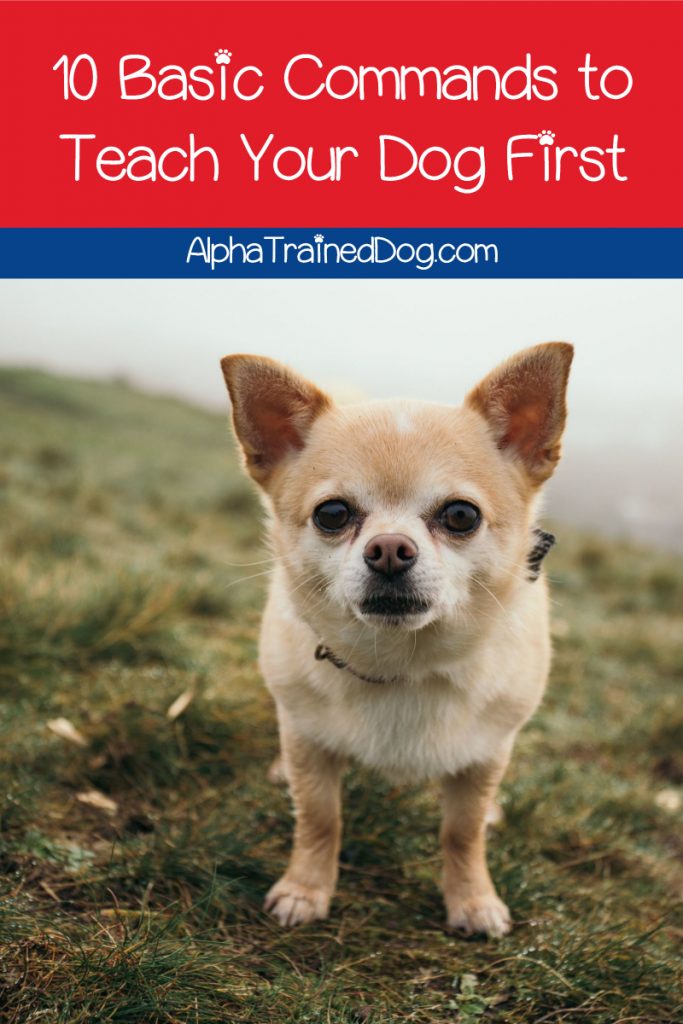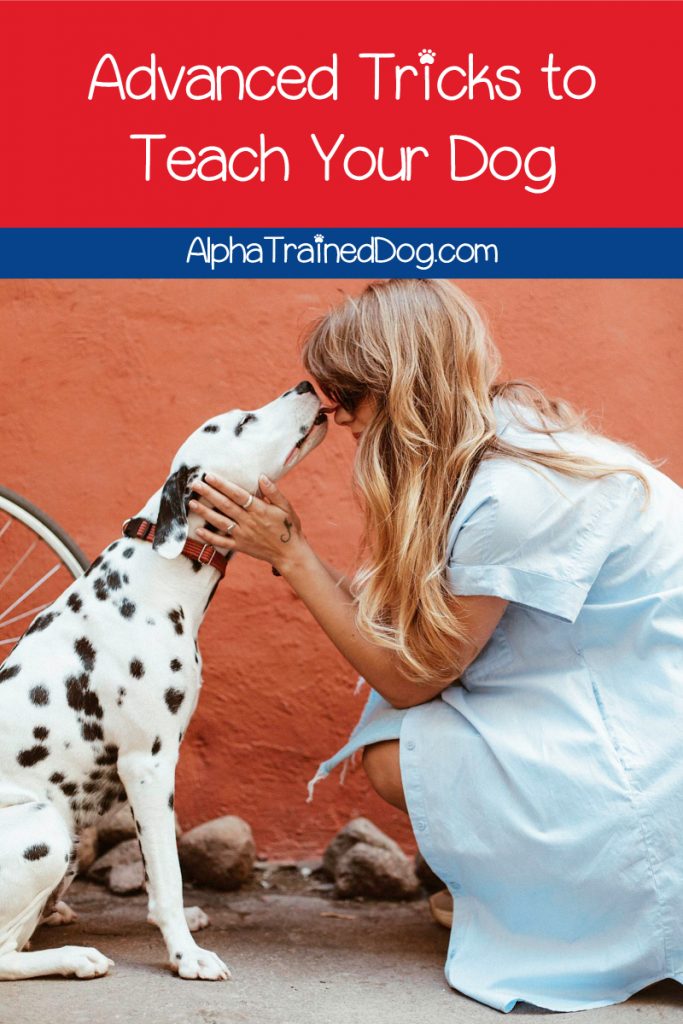What should I train my dog to do?
We’ve talked a lot about types of training strategies, breed-specific tips, even the best crates for different dogs.
Yet none of that really helps unless you can answer that one very basic question: What do I need to teach my dog?
So, today, we’ll head back to the beginning and go over the most important basic commands that every dog should know.
Then, we’ll check out some advanced trick training ideas to try after you’ve mastered them!

What Should I Train My Dog to Do?
That question has two potential answers, depending on how you ask it.
When I brought home my first pup, I asked myself, “What should I train my dog to do?” in a bewildered tone.
My real question was, of course, “What does my dog need to know to behave like a civilized canine?”
Today, I ask the question in a totally different tone. It’s more of an inquisitive, “What should I train my dog to do now?”
In other words, now that she knows the basics, what fun trick should we master together next?
Let’s start by answering the first question: What commands do all well-behaved dogs know?
Basic Commands Every Dog Should Know

These commands help our dog understand what we expect from her and let her know what she can expect from us.
I’ve listed them in the order that I taught my dog but they’re all equally important.
I’ll share my favorite video that demonstrates how to teach your dog each command.
I think that will be easier for you than having me try to explain the steps, as I’m notoriously awful at giving directions. 😀
You’ll notice that a good chunk are by Zak George. I love his methods because they’re completely force-free and based on positive reinforcement.
1. Potty Outside
If you want your dog to learn the appropriate place to do his business, you need to both show and tell him.
First, let me say that I abhor trainers who insist that you should teach a dog to pee and poop on command.
It’s completely irrational! The urge to go is controlled entirely by physiology.
No amount of barking “go pee!” is going to make your dog’s kidneys release urine into their bladders and produce that urge.
Instead, we use the “potty outside” command in a more general sense.
- First, when we take her out (or let her out in the morning into our fenced yard now that she’s older), we say, “Go potty outside.”
- After she does her stuff, I’ll say something along the lines of “Hooray for potty outside,” or “Good girl went potty outside!”
- If she does have an accident in the house, we take her out immediately and say, “Remember, potty outside.”
The nice thing about using this command (aside from teaching dogs where to go) is that they come to associate the word “outside” with the actual outdoors.
When my dog gets a little too wound up, I say “That’s outside play” and she runs to the door to be let out.
Combine this command with the tips from Zak George in the video below and you should have no problem potty training your dog.
2. Sit
“Sit” is always one of the first things I train my dog to do.
Not only does it teach your dog that we have to be calm, cool and collected before we get the good stuff, it’s also a vital part of many other commands.
Fortunately, as long as you’re using reward-based methods, it’s also one of the easiest to teach.
3. Down
Unless you want a dog that jumps all over everyone that walks through your door, you’ll want to teach your dog the “down” command ASAP.
Down is also a vital part of “settle,” so even if your dog isn’t a jumper, you’ll want to master it.
Force-free training is the best way to go in all cases, but it’s vital here.
“Down” makes your dog feel vulnerable because it puts him in a position where he can’t easily spring into action if he perceives a threat.
In other words, he needs to trust you, and that can’t happen if you’re using negative training methods.
4. Come
“Come” is one of the most important commands for your dog’s safety, as you can use it to call them away from danger.
It was also the hardest command to teach my Pharaoh Hound, since her breed has virtually no off-leash recall.
Our mistake was in trying to teach her to come by shouting “Freya, come” from across the yard.
When she’s on the hunt for her arch nemesis Mr. Squirrel, she’s too focused on her prey to really hear our commands. They simply don’t sink in.
Instead, I’ve found that by walking up to her and gently touching her, I can momentarily break her focus. Then she’ll follow my commands.
For this reason, she’s never, ever, ever off-leash in an area that’s not totally contained. Fortunately, we have a large backyard that’s fenced in.
Many other breeds are quite capable of coming when called, even off-leash. Check out the video below for tips on teaching your dog this command.
5. Stay
You’ll need to master the “sit” command (and, depending on where you’re issuing it, the “come” command) before you work on “stay.”
Basically, you’re teaching your dog to come back to you, sit down, and stay put.
“Stay” plays a role in “leave it” and “wait” as well, so you’ll want to master it before moving on.
6. Wait
“Wait” is typically used to teach your dog that he needs to chill out before he gets his food, but I find it useful for other things as well.
While Freya has no recall when hunting, sometimes we’re just running around the backyard for fun.
When it’s time to go in, I’ll say “Wait” and give the hand signal for it.
She knows that means it’s time to stop what she’s doing and wait to hear what I have to say next (which is usually “come inside”).
7. Leave it
Another super important command to help keep your dog safe, leave it tells them “that’s not for you.”
We also use it to tell Freya to stop messing with the cat. Sighthounds have super high prey drives, so when my cats run, she can’t help but chase them.
By telling her “leave it,” we’re reminding her that cats aren’t for chasing.
8. Drop it
Even if your dog has totally mastered “leave it,” there will be times when he gets his mouth on something he shouldn’t have, like your child’s favorite “can’t sleep without it” teddy bear!
“Drop it” tells him “Not yours, let go of it immediately.” If you have a stubborn dog, it is imperative that you do not shout this command.
Trust me, you’ll freak her out and she’ll end up swallowing it!
We’ve spent many a nights waiting for Freya to expel hair ties from one end or the other because we got a little too frantic with our “drop it” command.
9. Walk nice (heel)
I’ve had five dogs throughout the last 20+ years, and only two were brilliant at walking nice right off the bat.
Two more were fairly decent at it. They pulled like crazy at first, yes, but never to the point where they were dragging me. It didn’t take them long to learn to “walk nice.”
Freya, on the other hand, almost dislocated my shoulder the first time I walked her out front (she saw a cat). I was afraid to walk her for months after that!
When she got hurt and we had to keep her on a leash even in the backyard, though, I quickly learned how to teach her to “heel” and “walk nice.”
She still finds it a bit challenging out in front of our house (where the ferals live), but once we get going, she’s pretty calm now.
10. Settle Down
Up until Freya, we never taught a dog to “settle down.” All of my dogs have been pretty mellow.
Miss Freya, though, is the exception to every single rule.
If you have a “wild child” like I do, “settle” will help give you a few moments of peace so you can actually finish a TV show or read a book in peace.
If you mastered these basics, you’re probably wondering, “What should I train my dog to do next?” Why, tricks, of course!
Fun Tricks to Teach Your Dog

From simple tricks like “give me your paw” to advanced skills like “jump rope,” there are endless possibilities when it comes to trick training.
Here are a few of my favorites, along with video tutorials.
1. Shake Hands
Shaking hands is the easiest trick (and the first one I train my dog to do) to master.
You’ll need to know the “sit” command to make it work.
2. Speak
Want to know something interesting? Teaching your dog to speak is actually an important part of training them to stop barking on command.
After all, they have to know what you mean when you tell them to be quiet!
3. Give kisses
“Give kisses” is an adorable trick that always brings on the “aww” factor from bystanders.
Also, if you have a major licker on your hands, training him WHEN give kisses will help you train him when NOT to give them.
Sadly, my dog doesn’t really like to lick people, so we haven’t mastered this one. I respect her boundaries.
4. Fetch
Fetch isn’t just a fun game to play to tire out your dog (and you!), it’s actually pretty useful.
We use it to reinforce “drop it” and “leave it.” My dog brings me a ball, I tell her to drop it. She goes to grab it, I say “leave it.” Then I pick it up and toss it.
5. Learn names
One of my favorite things to train my dog to do is recognize the names of different toys.
We’re still working on it, but she’s got a few down pat. My aunt had a Border Collie that knew the names of every single one of his zillion toys. Super impressive!
Whether you’re teaching your dog basic commands or crazy tricks, just remember to keep it positive and make it fun for both of you.
Use training time to really solidify your bond with your dog and you should have no problem teaching him what you expect.


Potty outside is by far THE Most important one in my book. I remember teaching our dog to do tricks when I was a kid. It was fun and took a lot of patience (totally worth it too).